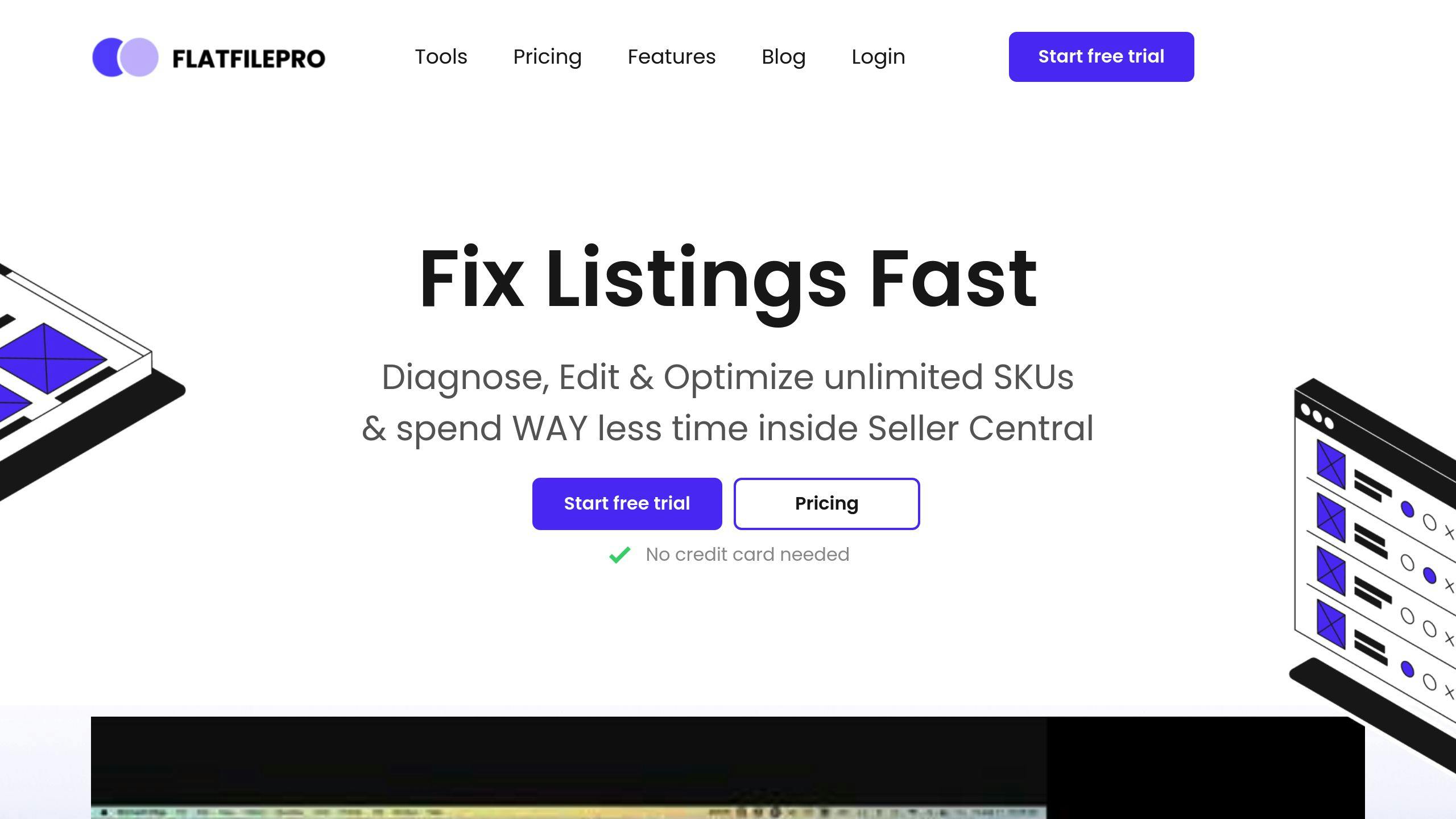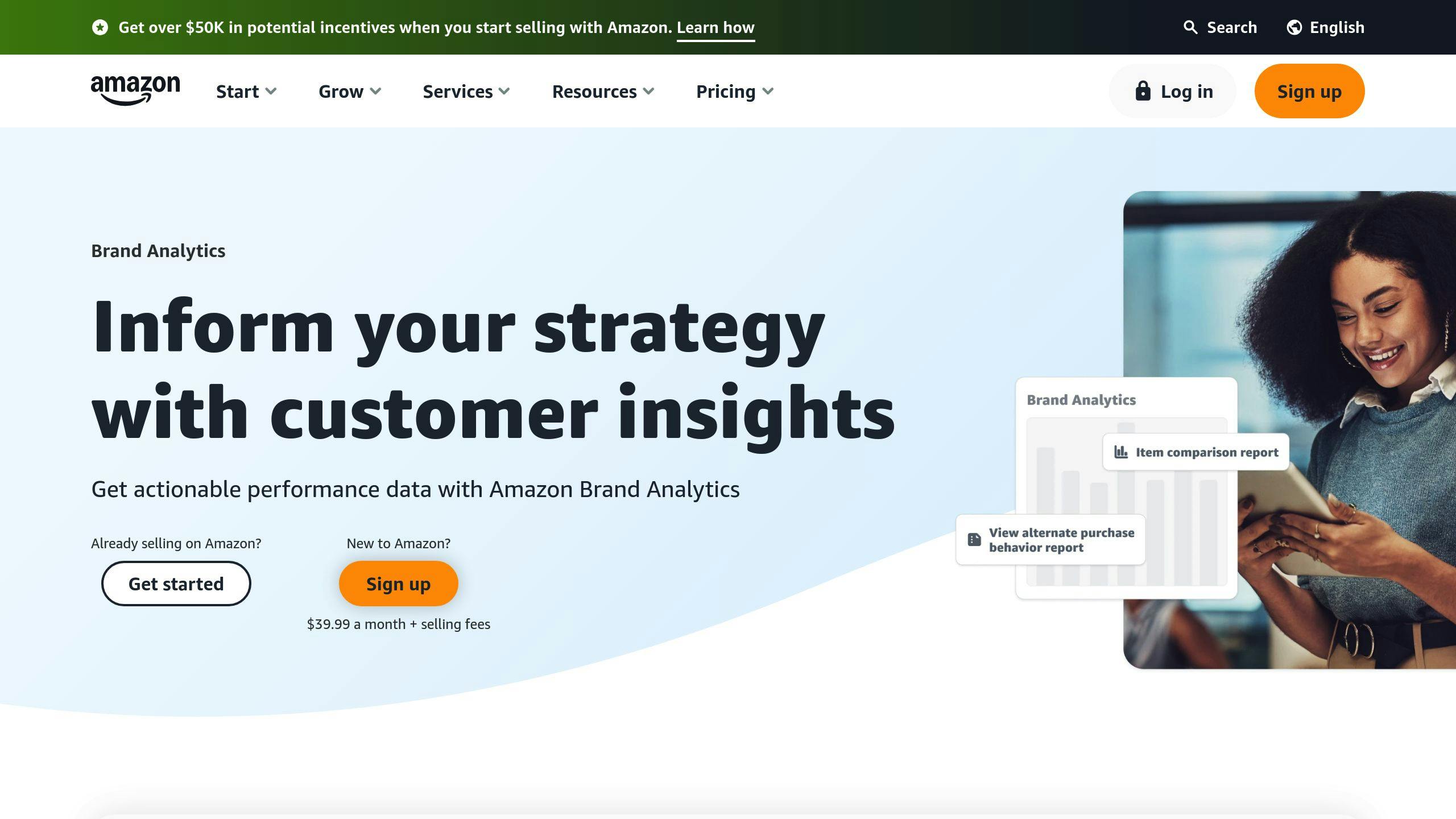Want to boost your Amazon sales across different regions? Here’s the quick answer: Tailor your product listings to match local search habits, cultural preferences, and market conditions. This means going beyond simple translations – think regional keywords, localized descriptions, and optimized pricing.
Key Takeaways:
- Regional Keywords: Research how customers search differently in each region (e.g., "sneakers" in the US vs. "trainers" in the UK).
- Localized Listings: Adjust descriptions, titles, and measurements to fit local preferences and standards.
- Market-Specific Pricing: Use dynamic pricing tools to stay competitive in each region.
- High-Quality Images: Customize visuals to meet regional expectations while following Amazon’s guidelines.
- Performance Tracking: Use tools like Amazon Brand Analytics to monitor and refine your regional strategies.
By focusing on these areas, you can improve visibility, increase conversions, and grow sales in multiple marketplaces. Let’s dive into the details.
Amazon’s International SEO Strategy Explained
Understanding Regional Amazon SEO
Selling on Amazon across different regions isn’t just about listing your products and waiting for sales. It requires tailoring your approach to fit the unique search behaviors, preferences, and challenges of each marketplace. The A10 algorithm takes regional factors into account, so sellers need to fine-tune their strategies for each target market.
Market-Specific Search Patterns
How customers search for products varies by region. For instance, US shoppers often use broader, more general terms, while UK customers lean toward specific, detailed phrases. These differences mean that optimizing your product listings requires understanding and catering to these regional search habits.
Geographic Performance Factors
Where your inventory is located, how much competition exists locally, and even shipping times can directly impact your product’s visibility. Regional demand also plays a big role. When sellers consider these factors, they can better position their products for success in each market.
Cultural and Linguistic Adaptations
Localization isn’t just about translating your listings. It’s about aligning with cultural expectations and language nuances. A well-localized product listing feels natural and relatable to local customers, increasing the likelihood of conversions.
Using Data to Optimize for Regions
Amazon Brand Analytics is a powerful tool to uncover region-specific keywords and trends. By analyzing this data, sellers can make smarter decisions about how to optimize their listings for different marketplaces.
Addressing Market-Specific Challenges
Every marketplace comes with its own set of hurdles. Pricing strategies, for example, often need to be adjusted based on local competition and market conditions. Dynamic pricing tools can help sellers stay competitive while accounting for these regional differences [3].
Technical Tools for Regional SEO
Managing multiple regional marketplaces can get complex. Tools designed for catalog management can simplify the process, ensuring your branding stays consistent while adapting to local market needs.
1. Perform Regional Keyword Research
Understanding how people search in different regions is key to optimizing your Amazon listings. Regional keyword research helps you match your products with local search habits.
Leverage Amazon’s Built-In Tools
Amazon Brand Analytics can provide insights into top-performing regional search terms. It also offers data like impressions, click-through rates, and cart adds, making it easier to pinpoint impactful keywords.
Focus on Long-Tail Keywords
Long-tail keywords reflect regional specifics. For example, shoppers in the US might search for "patio furniture", while in Australia, they might look for "UV-resistant outdoor lounge set." These keywords help you tap into niche markets with less competition.
Consider Local Language and Culture
Tailor your listings to fit local terminology – think "sneakers" in the US versus "trainers" in the UK. Pay attention to seasonal timing and regional preferences. Adding local slang or idioms to product descriptions can also make your listings feel more relatable.
Use Tools for Efficiency
Platforms like FlatFilePro can simplify the process of adding regional keywords. These tools allow for bulk editing and make managing multiple marketplaces easier.
Study Your Competitors
Look at what your competitors are doing. Find out which keywords they’re ranking for, adjust your product titles accordingly, and even refine your pricing to better suit the local market.
Once you’ve gathered your region-specific keywords, the next step is integrating them into your product listings to boost visibility and attract the right audience.
2. Tailor Product Listings for Regional Markets
After identifying regional keywords, the focus shifts to integrating them into your product listings while addressing the specific needs of local customers. This goes beyond simple translation – it’s about aligning with local shopping habits and expectations.
Adjust Product Descriptions
Write descriptions that speak directly to regional needs using familiar, relatable language. For example, when selling winter clothing, highlight insulation and warmth for colder regions like Canada. On the other hand, for warmer areas like Australia, emphasize breathability and lightweight features.
Refine Product Titles
Incorporate high-performing regional keywords into titles without compromising clarity. For instance, titles for US shoppers might prioritize size and specific features, while UK listings should include metric measurements and terms like ‘parasol’ instead of ‘umbrella.’
Customize Technical Details
Ensure technical specifications align with regional standards. This might include:
- Converting measurements (e.g., inches to centimeters)
- Adjusting power requirements (e.g., voltage and frequency)
- Updating weight units (e.g., pounds to kilograms)
Factor in Regional Seasons
Match your product listings to regional seasons and shopping trends. For instance, shift your focus and promotions to reflect the opposite seasonal patterns between the Northern and Southern Hemispheres.
Use Regional Trust Indicators
Include certifications and compliance badges that resonate with local buyers. For example, adding CE marking for European markets or RCM certification for Australia/New Zealand can help build trust and credibility.
Set Dynamic Pricing
Develop pricing strategies tailored to each region, taking into account:
- Currency fluctuations
- Local competition
- Regional operating costs
- Purchasing power in the area
Once your listings are fine-tuned for regional markets, the next step is to ensure your visuals appeal to audiences across different regions.
sbb-itb-ed4fa17
3. Use High-Quality Product Images
Clear, professional images can help increase conversions by connecting with regional audiences. Your visuals should match local preferences while following Amazon’s marketplace guidelines.
Professional Photography Standards
Ensure your product photos meet Amazon’s standards: use a white background, have the product fill at least 85% of the frame, and keep the images sharp and clear. This ensures your products look great on any device [3].
Adapting to Local Preferences
Tailor your images to align with cultural expectations. For instance, consider clothing styles, lifestyle settings, or even the background elements in your photos. In more conservative markets, make sure clothing and presentation reflect local values.
Key Image Types to Include
To appeal to a global audience, make sure your product listings feature these types of images:
- Main product shots: Highlight the most important features.
- Multiple angles: Help buyers feel confident by showing every side of the product.
- Lifestyle images: Show how the product fits into daily life, keeping local context in mind.
- Size references: Use objects familiar to the region to illustrate scale.
- Infographics: Include measurements in units commonly used in the target region.
Mobile Optimization and Trust Markers
Test your images on various screen sizes to ensure key details stand out, especially for mobile users. Add trust symbols relevant to each market:
- Europe: CE markings, safety certifications.
- Asia: Region-specific certifications.
- North America: FDA or USDA labels, where applicable.
Managing and Optimizing Images
If you’re selling in multiple regions, tools like FlatFilePro can simplify image management while keeping your listings compliant with Amazon’s rules. Also, optimize your alt-text by including keywords specific to each region. This improves both accessibility and local search rankings [1][2].
Using the right visuals, tailored for each region, can make a big difference in how your products are received by global audiences.
4. Use FlatFilePro for Regional Listing Management
Managing Amazon listings across different regions can be challenging. FlatFilePro makes it easier with tools designed for bulk updates, tracking changes, and handling international marketplaces – all aimed at simplifying the process and improving regional SEO.
Bulk Editing for Regional Needs
With FlatFilePro, you can update titles, descriptions, keywords, pricing, and inventory for multiple regions at once. This feature ensures consistency across listings while saving you hours of manual work. Plus, it allows you to tailor your listings to specific regional needs without the hassle.
Version Control for Clear Oversight
FlatFilePro’s version control helps you track changes, roll back updates if needed, and maintain an audit trail. This means your team can collaborate effectively while keeping your listings consistent and error-free across all marketplaces.
Tools for International Marketplaces
FlatFilePro offers features like real-time tracking of listing changes, simplified management of product variations, and region-specific access controls. These tools ensure your listings stay accurate and adaptable to the unique requirements of each Amazon marketplace.
Simplifying Regional Compliance
The platform helps you meet regional compliance standards with automated templates, validation checks, and error detection. This not only keeps your listings compliant but also ensures they perform well in search results.
Focus on Strategy, Not Manual Tasks
FlatFilePro centralizes listing management, automates updates, and catches errors early. These features allow you to:
- Monitor multiple marketplaces from a single dashboard.
- Apply effective listing strategies across regions.
- Keep your branding consistent while adjusting for local markets.
5. Track and Evaluate Regional Performance
Once you’ve implemented regional SEO strategies, the next step is to measure how well they’re working. By keeping an eye on key metrics and using data to guide your decisions, you can boost visibility and sales in different markets.
Key Metrics to Watch
Here are the metrics you should focus on for each region:
- Sales Volume: Spot demand trends and adjust your inventory and marketing accordingly.
- Conversion Rates: See how often visitors turn into buyers and tweak your listings to improve.
- Click-Through Rates (CTR): Check how often people click on your listings to gauge visibility and appeal.
- Return on Ad Spend (ROAS): Compare how effectively your ads perform in different regions.
How to Use Amazon Brand Analytics
Amazon Brand Analytics can provide valuable insights to improve your regional strategy. Here’s how you can use it:
- Optimize product titles and keywords for specific regions.
- Adjust listings based on demographic data.
- Find opportunities for cross-selling.
- Keep tabs on your competitors’ positioning.
| Metric | Purpose |
|---|---|
| Search Terms | Fine-tune regional keyword strategies |
| Demographics | Align with local audience preferences |
| Market Basket | Improve cross-selling opportunities |
| Item Comparison | Analyze competition in specific regions |
Setting Up a Review Schedule
To stay on top of performance, set a clear review schedule:
- Monthly: Make small, quick adjustments.
- Quarterly: Dive deeper into trends and insights.
- Annually: Plan larger, strategic changes.
Experimenting with Regional A/B Testing
Run A/B tests on elements like titles, descriptions, pricing, and images for 2-4 weeks. Focus on:
- Listing details that resonate with local shoppers.
- Price points that balance conversions and profits.
- Visuals that grab attention in specific regions.
Using Data to Make Regional Adjustments
Leverage your performance data to improve your strategy:
- Shift inventory to match regional demand.
- Adjust pricing based on local market feedback.
- Update content to better engage regional audiences.
- Reallocate marketing budgets for better returns across marketplaces.
Conclusion
Expanding your reach on Amazon requires a strong focus on regional SEO. By tailoring your approach to specific markets, you can achieve up to a 25% boost in search visibility through effective keyword optimization.
Here’s how optimizing for regional markets can make a difference:
| Benefit | Impact |
|---|---|
| Better Local Visibility | Higher rankings in specific markets |
| Higher Conversion Rates | Listings that meet customer needs |
| More Sales | Deeper market penetration |
| Improved ROI | Smarter use of marketing budgets |
Consistency and regular updates are essential. Amazon’s future leans heavily toward personalized, regional strategies. To stay competitive, you need to stay ahead of these trends, refining your approach to match local market behaviors and preferences.



